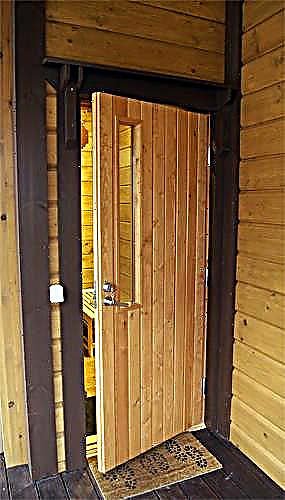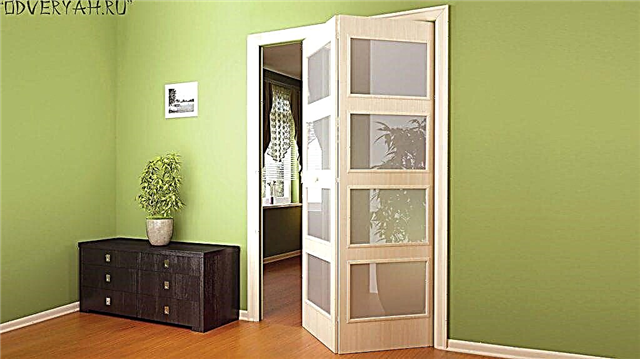 Why do you need to insulate a house? Most likely, this question will be perplexing for many inhabitants.
Why do you need to insulate a house? Most likely, this question will be perplexing for many inhabitants.
A residential building must be insulated. If you make the thermal insulation of a residential building reliable, you will be able to create a stable internal microclimate at any time of the year. Thus, the temperature difference and the vagaries of nature will not depend on how comfortable the homeowner and all members of his family will live. Also, by warming the house, you will provide all the elements of the structure with reliability and increase their durability.
Before embarking on the construction of a private house, it is best to think over the issue regarding the insulation of not only the walls and ceiling, but the entire structure. These activities can be performed not only at the construction stage, but also during the operation of the building (this is best done in the warm season).
If a residential building has poor thermal insulation performance, this will negatively affect not only the people living in the house, but also the building itself.
All members of your family will be prone to frequent colds. Living in cold rooms will not be comfortable. The walls of the house will be susceptible to freezing, and then mold and mildew on them.
If all structural components of the building will have increased thermal conductivity, this will cause self-destruction of building materials.
One conclusion suggests itself from the above: a residential building needs to be insulated. And how this can be done should be decided by each homeowner individually.
You can insulate the house with one of these materials:
Foam for wall insulation: types and features
To insulate walls, modern masters use various materials and technologies for work. They have significant differences among themselves, but they are all designed for one purpose - to make the thermal insulation of the house as productive as possible.
Liquid foam for wall insulation is called polyurethane foam (PUF).
All the necessary ingredients are mixed in the factory and the composition necessary for polymerization is under high pressure in the cylinders. In order for the foaming and hardening reaction to occur, contact of this composition with oxygen is necessary.
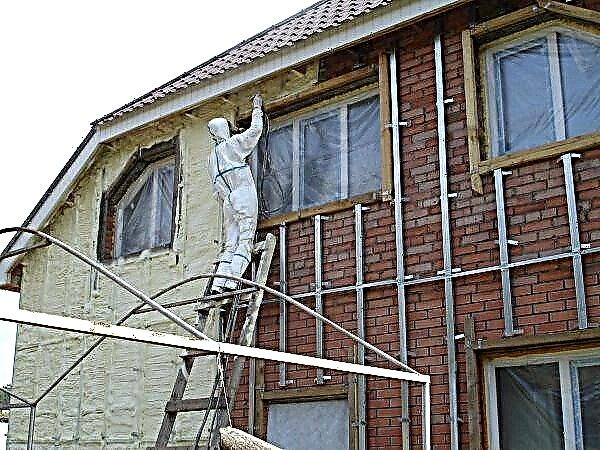
Is it worth it to insulate the walls with foam? Of course, it’s worth it for one simple reason - polyurethane foam is an ideal material for this purpose, moreover, it performs another very important function - sound insulation.
What is a foam insulation? This is a special malleable mass which, when interacting with air, has the property of foaming. This composition has a fairly strong and elastic structure. For its spraying use cylinders, pneumatic devices and other devices.
Today, in the construction of frame-type houses, the sections between the "sandwich panels" are filled mainly with foam insulation.
Advantages and disadvantages of insulation with foam means
The main advantages of the insulation:
- The ability to process even large areas in a short period of time.
- Lack of seams.
- This material is not subject to rotting processes, nor does mold and fungus form on it.
- This is a non-flammable material that is not subject to burning, it can only melt.
- Interacting with a metal coating, a dense anti-corrosion protection is created.
- The result is a flat surface, which is characterized by excellent heat-saving properties.
- Foam does not deform the base on which it is applied.
- Light weight.
As for indicators such as environmental friendliness and durability, I want to say the following: The material is absolutely safe for long-term use in residential premises.

The disadvantages inherent in this type of insulation:
- It is negatively affected by direct sunlight.
- Material may become unusable from continuous contact with water.
- The tool is not cheap.
- For its application, special conditions must be created.
- When working with foam heaters, you need to use a special canvas suit, gloves, a respiratory mask and safety glasses.
- Since this material has a low level of vapor permeability, phenomena that are characteristic of those that occur in a thermos are formed inside the building. Therefore, it is imperative to equip a compulsory room ventilation system.
What is the best way to insulate a building with foam - outside or inside?
It is difficult to give an unambiguous answer to it, but we will try to do it. One of the varieties of liquid foam - penoizol is used for thermal insulation frame buildings. This material fills the air gaps between:
- external and internal walls
- wall and plastic panel,
- wall and drywall sheet,
- floor base and floor covering.

Insulation inside and out
Using mounting foam, plates made of solid heat-insulating materials are fixed, and the joints between them are also filled with foam.
Some homeowners insulate the facade of the building with foam.
Polyurethane is used to eliminate minor defects present on the walls.
You will get an equally good result if you insulate the walls of frame-type houses, the roof, the attic, the facade of the house, as well as the basement and lower floor with polyurethane foam.
Types of foam insulation: polyurethane foam and polyurethane foam
For construction needs, there are a large number of different types of foams on the market, we will not consider them all in detail. For example, take only a few of them, which are considered the most popular and effective. It will be about assembly foam and polyurethane foam.
Foam is used for:
- Achieving a good soundproofing effect. To do this, fill the joints of the pipes and holes in the wall with foam. Thus, it is possible to significantly reduce the noise level from the heating system, water supply system and working air conditioners.
- Need thermal and waterproofing. Using the mounting foam, you can carefully seal cracks, voids around the pipes, as well as the empty space resulting from the installation of door and window frames. The main purpose of the mounting foam is sealing.
- Bonding. With its help, you can firmly connect with each other a variety of elements made of various materials.

PPU is made in cylinders and has the following features:
- Polyurethane foam has excellent thermal insulation properties.. Therefore, it is widely used as insulation and sealing material in construction.
- The properties of this material directly depend on the additives used in its production.
- By spraying polyurethane foam, you can easily and without any problems to insulate the design of any shape. The material is not afraid of dampness, it steadily tolerates the effects of acids and alkalis. And also it is too tough for rodents and various insects.
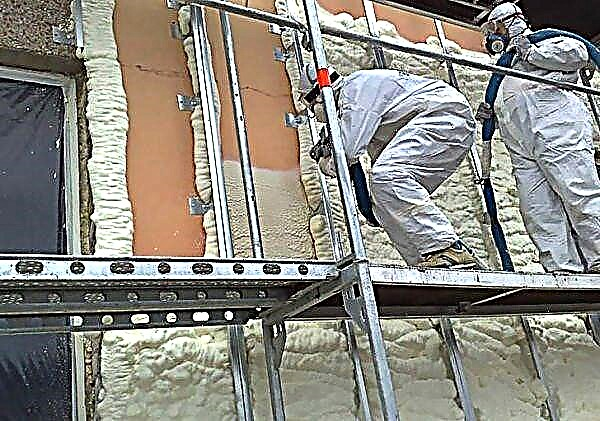
Wall cake
The device wall "pie" frame house:
- interior decoration
- vapor barrier layer
- insulation
- frame rack
- windproof layer
- transverse lathing,
- vertical crate,
- exterior finish.

If you plan to carry out thermal insulation of rooms from the inside, you need to do all the work in stages. One of the main issues that you should pay special attention to is the correct placement of a vapor-insulating film in a heat-insulating “pie”.
Vapor barrier can be made of:
- reflective film
- diffusion membrane
- vapor condensate film.
When installing a vapor barrier material, one important point must be taken into account: it must be mounted on top of the insulation from the side of the room. If you plan to insulate the wall with mounting foam, then you do not need vapor barrier.
Do-it-yourself lathing and foam application
The aluminum profile must be fastened in vertical rows to the ceiling and walls. Further, the crate is strengthened with horizontal jumpers (step 0.5 meters) Do not forget to fasten the profile around the perimeter of the doorway of the window.
In order not to stain pipes and communications, their need to close with a film.

Rules for applying foam insulation in cylinders:
- First of all, you need to take care of safety measures.
- Then you need to spray a small amount of automotive silicone grease onto the mounting gun.
- Next, insert the can onto the gun and tighten it tightly.
- Now you can apply the mounting foam to the right place.
- The spray can must be removed from the gun and cleaned (the gun) with a special compound.
- If the foam is not fully consumed, rinse with a cleaner and the valve located on the bottle.

Foam application on the wall surface
Waterproofing
Foam is also used for waterproofing. It increases in volume under the influence of moisture and hardens within a day.
Polyurethane foam with waterproofing properties is sold in cans. It is endowed with high waterproofing and fixing indicators. It is used for both external and internal works.
This versatile material is not afraid of water and high humidity, so it is widely used in everyday life.
Output
Foam insulation can be used for walls made of various materials, including aerated concrete, blocks and reinforced concrete panels. Therefore, they are used for warming private cottages and apartments. Before giving preference to any one of the varieties of foam, consult a specialist.
If you decide to insulate the house with liquid foam - this is the right intention. Always try to buy raw materials from the best domestic and foreign manufacturers. So you can avoid premature wear of structures.
Features of the material used
Liquid foam for insulation procedures is an excellent and reliable product. The most popular material is polyurethane foam.
Before you start the insulation procedure yourself, you must wear specially designed clothing.
After spraying, you can start spraying, you need a special tool, spraying should be done carefully. The main distinguishing feature of polyurethane foam is quick solidification.
After that, the material fills the entire space between the rafters or beams, which are located vertically.
Consider a brief description of this fast-moving product:
- foam for wall insulation steadily tolerates high temperatures (about 80 degrees Celsius),
- she is able to pass water
- has excellent vapor barrier performance,
- the material is strong enough to mechanical damage,
- some liquid heat insulators can increase in volume. For example, a heat insulator Corund.
In addition to wall insulation, liquid polyurethane foam is excellent for sealing various gaps on the surface. Therefore, with its help, you can easily install plastic windows.
Also, this insulation material has excellent refractory parameters. The main disadvantage of this product is that it cannot be used in rooms that are not ventilated at all. In such conditions, it is simply not able to harden.

Do-it-yourself foam insulation allows you to achieve a monolithic coating. On such a surface there will be no seams and joints.
One bottle can hold 700 milliliters of foam. It is used for one square meter of insulated surface, the thickness of which is about four centimeters.
For operation, the foam cylinder must be installed in a specially designed gun for installation. The principle of operation is that you pull the trigger of a construction gun, and send a tight stream of material to the surface of the wall.
After a day, the product can completely harden.
A tool such as a pneumatic gun is used for thermal insulation:
- external walls of the apartment,
- balconies and loggias,
- foundations of the house (foundation),
- various pipes.
Types of thermal insulation foam
Consider the most popular varieties of this building material:
- the first type is ordinary polyurethane foam,
- the next variety is polyurethane foam, which consists of two components,
- the third type is liquid foam. Another name is penoizol,
- other liquid heat insulators designed for walls.
We discuss each type of insulation separately.
Is it possible to insulate the walls with foam
 It is widely used for wall insulation on the outside and inside. Apply using a special device or a gun. The material fits well on a vertical, horizontal and inclined surface.
It is widely used for wall insulation on the outside and inside. Apply using a special device or a gun. The material fits well on a vertical, horizontal and inclined surface.
Features of wall insulation:
- The walls become thicker, which leads to greater resistance to environmental influences.
- The material is able to withstand temperatures up to +80.
- Vapor permeability.
- Resistance to various damages. It will not crumble from the impact, does not deform.
- Material does not burn.
Such objects are insulated:
- window openings
- walls from the street
- foundation,
- balcony, attic,
- pipelines
- attic rooms.
After application, there are no seams and joints. Foam hardens from 1 to 3 days, depending on the number of layers applied.
Inside
 Insulation indoors is carried out as a last resort. Only when it is not possible to carry out work if the apartment is on the upper floors. This is indicated in SNiP 23-101-2004.
Insulation indoors is carried out as a last resort. Only when it is not possible to carry out work if the apartment is on the upper floors. This is indicated in SNiP 23-101-2004.
Carrying out wall insulation indoors, you should take care of waterproofing, because the dew point is shifting. The walls will be wet, which will lead to the appearance of fungus and the destruction of the supporting structure.
Outside
Insulation from the outside is the right solution. The main factor is not a dew point violation. The walls will be warm and dry.
Advantages of insulation from the outside:
- High energy saving data.
- Inside, the footage remains the same.
- No condensation.
- Sound insulation indicators are improving.
Disadvantage: foam insulation requires the use of equipment.
Even with the overestimated cost of the material, the equipment used, the work of the craftsmen, it pays off by saving (payment for heat), silence, comfort.
Advantages and disadvantages
 The foam used for insulation has a number of features that distinguish it from other materials:
The foam used for insulation has a number of features that distinguish it from other materials:
- When applied, penetration into all cracks occurs, sealing them.
- High rate of thermal insulation.
- After mounting on the surface there are no seams, joints.
- A light weight. This does not give load to the bearing walls and the foundation.
- After hardening, the foam does not pose a threat to human health and the environment.
- Increases sound insulation performance.
- Contact with metal elements does not cause corrosion.
Disadvantage: the cost of material and equipment.
Penoizol
Penoizol belongs to the group of foamed plastics and, after hardening, forms a fine-meshed inelastic spatial structure. The urea polymers are the chemical basis of plastic. Penoizol is supplied as:
- liquid composition for spraying,
- molded flat plates
- granules to fill the voids.
Penoizol is perfect for warming frame buildings. It actively foams and fills the gaps between:
- internal and external walls
- sheet panels (plasterboard, plastic, OSB) and a wall,
- rough and fine floor.
Progressive material is widely used for thermal insulation of pipelines for various purposes.
Its main advantages are:
- high application rate
- resistance to temperature and moisture,
- long period of operation,
- low flammability
- elasticity and resistance to deformation.
 Drawing foam on a wooden house
Drawing foam on a wooden houseIt is not susceptible to mold formation and unpleasant to the taste of rodents. Like other foamed materials, it perfectly absorbs noise and scatters vibrations.
Assembly foam in cylinders
 This is a one-component heat insulator. Warming can be carried out independently.
This is a one-component heat insulator. Warming can be carried out independently.
Types of polyurethane foam:
- facade - having a large temperature range. It can withstand minus and plus temperatures,
- usual - for sealing cracks, sealing joints,
- with extra strength
- glue foam.
To apply the material use a construction gun.
Spray foam
Polyurethane foam consists of 2 substances. This is the best material for thermal insulation of a building. For installation, balloon equipment is used. Material on the surface hardens within 10-20 minutes. Structure - closed cells, which have a minimum indicator of thermal conductivity, sound insulation, moisture penetration.
One layer of the applied material is 6 cm thick. Sometimes after complete hardening, apply 2 coat for strength.
The difference is very good adhesion with various materials.
Is it possible to insulate foam with your own hands
 Basically, they independently conduct internal insulation work. To do this, you need:
Basically, they independently conduct internal insulation work. To do this, you need:
- Wooden slats or metal profiles as guides for the lathing.
- Foam in spray cans and a construction gun.
- Construction knife.
First, the surface in the house is cleaned of dust, cvili, cobwebs. After that, profiles are fixed in increments of 50 cm. Vertically along the wall, with horizontal jumpers 50 cm.
- Safety: glasses, protective clothing, gloves.
- Apply a little automotive grease to the construction gun for better performance.
- Insert the can into the gun.
- Apply foam to the surface.
After work, clean the gun. If liquid remains in the cylinder, close it tightly.
Wait until complete drying - from 1 to 3 days. After finishing the finish.
Installation of wooden or metal beams
 Before mounting the crate, it is necessary to prepare the surface.
Before mounting the crate, it is necessary to prepare the surface.
Cleaned from dust and cobwebs.
If the installation work is carried out on the street, then they are cleaned of the old whitewash, swollen plaster, pieces of cement, and other sticking objects.
After cleaning, the guides (wooden battens or metal profiles) are fixed in increments of 50 cm. For strength, horizontal bridges are made every 50 cm. Hardware is used depending on the surface material (anchor, dowel-nails).
All work on laying electrical cables and other communications is done before the start of insulation. Electric wires are laid in the corrugation.
Foam sprayer application by compressor
First, the material must fill all cracks, joints, cracks. This will save you from voids where a cold bridge may occur. As well as voids that occurred at the junction of the crate and the surface.
After this, spraying is done with smooth sweeping movements from side to side. The surface is covered from top to bottom.
When doing work, make sure that the crate remains visible. The finishing coating (drywall, particleboard, other materials) will subsequently be fixed on it.
Drying
 Foaming of the material takes place inside the equipment. After application, the hardening will be in 15-20 minutes. Full drying occurs in a day or three.
Foaming of the material takes place inside the equipment. After application, the hardening will be in 15-20 minutes. Full drying occurs in a day or three.
Experts recommend proceeding to finishing after 5 days.
Alignment
After 5 days, you need to level the surface before the finish. To do this, cut off excess hardened foam with a construction knife. Do this in a level with a crate. The surface should be flat, without hollows and bumps. If it is difficult to work with a knife, take a hacksaw with small teeth.
After that, the finish is fixed on the prepared surface.
Finish
The surface of their foam is not covered with various types of plaster, putty, wallpaper. For facing apply:
- drywall (ordinary, moisture resistant),
- plastic, glass wood panels,
- lining
- Particleboard, fiberboard, OSB.
The hardware is fixed on the previously created crate. A waterproofing layer is not required.
How long will the foam serve as a heater
 Thermal insulation material does not have a limited service life. After installation, the foam collapses when exposed to:
Thermal insulation material does not have a limited service life. After installation, the foam collapses when exposed to:
- direct sunlight
- UV exposure
- carrying out silicification.
Therefore, the insulating layer on top is covered with a finishing material that serves as a protective layer.
Under the lining, the service life of the foam is unlimited.
Is it possible to enhance sound insulation in this way
Foam has sound insulation indicators. This is affected by:
- The thickness of the applied insulation layer reflects the incoming noise.
- Elasticity absorbs vibration from sounds.
- The tightness of the seams and cracks does not allow noise to enter the room.
But, the foam in the cylinders does not have such indicators as the material sprayed through the equipment.
The only type of foam in cylinders that has good performance is MAXFORTE SoundFLEX.
Today, foam is widely used for wall insulation inside and outside. It is used in attics and basements, in attics and loggias. Produce insulation of the pipeline and chimneys.
The material has many positive sides, has good soundproof performance. Using insulation, it is worth familiarizing yourself with the application method, as well as consider the lining.
Features of insulation
For the independent implementation of warming the house with foam, a protective suit is required. Foam is usually sprayed from a cylinder on the entire surface of the facade, it fills the voids between the walls, rafters, beams.
The advantages of this type of wall insulation with foam in the air gap are many. The main ones include:
- vapor permeability
- fire resistance
- ability to increase in volume,
- resistance to various kinds of mechanical influences,
- the upper temperature limit remains within +80 degrees.
 Often, foam is used to seal the cracks that remain after installing plastic windows. Due to this, the insulation also increases in the apartment. It is convenient to use the air gun for warming not only windows and external walls, but also the basement, a loggia and a balcony, pipes.
Often, foam is used to seal the cracks that remain after installing plastic windows. Due to this, the insulation also increases in the apartment. It is convenient to use the air gun for warming not only windows and external walls, but also the basement, a loggia and a balcony, pipes.
The facade after processing with foam insulation for walls is ideal - without visible joints and seams. One cylinder contains an average of 600-700 ml of the composition, which is enough to process a square meter with a layer up to eight centimeters thick. Working with such a gun is very simple: first a full cylinder is inserted into it, then you need to point it at the surface to be machined and pull the trigger. On average, the applied composition solidifies within a day.
Two-component polyurethane foam
To make a complete thermal insulation of the wall surface, you need to use a polyurethane mixture, which consists of two components.
In this situation, the substance begins to foam as a result of a chemical reaction that occurs between the elements of this insulation material. Due to this, this mixture can increase in size many times.
The curing process of the PUF is only a few minutes. 90% of the product’s structure is closed cells. Due to such indicators, the two-component polyurethane foam has minimal values of thermal conductivity, moisture absorption and vapor permeability.
The polyurethane foam layer should be 6 centimeters.
A distinctive feature is the excellent adhesion of the material to other surfaces (adhesion). Before starting the thermal insulation procedure, it is necessary to buy aerosol cans containing polymer. The volume of such thermal insulation cans is one liter. One-liter spray is enough for one square meter.
When applying the material, it is necessary to observe the temperature in the room, it should be room temperature (20-25 degrees Celsius).
Avoid direct sunlight. If it is raining or cold outside, then the procedure does not need to start, because the product may not foam well. As a result, the overall process will take more than five days.
Polyurethane is also used for houses that are already old. They have weak rafters and a foundation.
At the moment, foam insulation in cylinders is the most effective heat insulator. But there is similar material. Consider it.
Polyurethane foam
Foamed polyurethane forms a closed-cell structure during solidification. This increases the strength of the material compared to conventional construction foam. It is applied with a layer of 5-10 cm, has good adhesion to the main materials:
Thanks to the closed form of microcells, it practically does not absorb liquid and by itself serves as a waterproofing agent. It is used both outside and inside buildings.
The main advantages of penoizol are:
- low specific gravity
- high fluidity in liquid and foamed state, the ability to fill cavities and gaps of any shape and width,
- low vapor permeability,
- biological resistance, repelling mold and rodents.
 Thermal insulation of internal walls
Thermal insulation of internal wallsThere is a minus to the material: for its use, you will have to buy a special atomizer and container.
Heat insulating paint
In addition to foaming materials, there is also another liquid heat insulator - ceramic paint. It is used on stone, brick, foam concrete surfaces as a complex coating, serving for:
The main purpose of such a paint is waterproofing. The effect of warming is concomitant. To achieve a warming effect comparable to a 20 mm layer of penoizol, such a paint will have to be applied in at least 10 layers. The paint is excellent for vapor barrier of complex joints of building structures that are difficult to protect from moisture in other ways.
 Ceramic Insulating Paint
Ceramic Insulating Paint
Myths about the harmfulness of foamed plastics
Conspiracy theorists and unscrupulous advertisers of competing classes of thermal insulation products often spread rumors of the terrible health damage caused by foamed plastics.
If understood without hysteria and exaggeration, polyurethane foam really has one property that carries a potential threat.
During combustion, it can form toxic volatile substances based on formaldehyde resins. During a fire, this may be an additional risk factor for those who did not manage to leave the burning room.
During the application of the foaming composition, a certain amount of inert gas and other chemical compounds are also released.
However, after the foam coating has completely hardened, no harmful emissions occur during its entire life. The complete film surrounding each microcell is chemically inert and impermeable.
Summarizing, we can say that the foam coating is completely safe during operation.
During application, all safety precautions specified in the user manual should be observed:
- use only working equipment
- to exclude the use of open fire and high-temperature heating devices during application,
- use personal protective equipment: respirator, gloves, protective overalls with a hood and tight shoes,
- when working indoors, provide ventilation
- Do not use the premises for people to stay in them until the composition has completely hardened (usually 24 hours.)
Of course, during the operation of the foamed coatings in the house, it is necessary to establish and adhere to the fire safety rules.
Popular equipment, cost and features
High-performance universal installations for spraying a foam coating of a professional level cost hundreds of thousands of rubles. It makes sense to acquire them if it is planned to open a thermal insulation business. At one house they will not pay off.
Household devices are cheaper, they are divided into two classes:
Disposable
This is a factory assembled unit with charged components. Her virtues
- minimum preparation for work and ease of use,
- low price,
- After use, there is no need for washing and preservation.
- a fixed volume of the composition and, accordingly, the area covered during the use,
- an accurate calculation of the purchased sets is necessary - it may not be enough or extra ones may remain.
It makes sense for beginners who don’t want to spend time sorting out the settings, refueling and caring for a reusable installation.
Proton home
- A popular rechargeable installation costs from 25 tr.
- allows you to spray coatings of any density,
- productivity - 2 kg of mixture per minute, which corresponds to 25-30 m2 with a thickness of 2 cm.
- the cost per square meter of coverage is about 560 rubles, the smallest among analogues.
- Cheapness results in the absence of subtle adjustments to process parameters.
- A good choice for beginners.
 Domestic installation Proton Home
Domestic installation Proton Home Air light
A more productive (up to 4 kg of mixture per minute) universal rechargeable installation allows you to work with built-in cylinders and take components from 100- and 200-liter barrels. It is equipped with a frame and wheels for ease of movement around the construction site. Reasonable to purchase if large volumes of foam insulation are foreseen
Cost - from 80 thousand rubles.
 AirLight Mobile Installation
AirLight Mobile Installation
Foam kit 600
Kit for applying 56 m2 of coating, disposable, pre-configured.
 Disposable Foam Kit 600
Disposable Foam Kit 600
It costs about 35 thousand rubles, the kit includes everything you need to apply the composition loaded into the cylinders, including replaceable nozzles for the gun and protective gloves.
Warming process
Do-it-yourself foam coating is quite within the power of a home foreman with initial spray painting skills. When working with household installations of the initial level, as a rule, one person copes. When installing the crate and when working with high-performance devices with long hoses, an assistant will be required to transfer them, as well as move containers with components.
Getting Started
Before proceeding, it is necessary to prepare the surface for coating. Remove old wallpaper, paint, and anything that could prevent the foam from sticking to the surface.
Then, with a step of 50 cm, vertical guides are attached to the wall - wooden blocks or a metal profile. They are intended for fastening the finishing material - drywall, lining or other. If there is no decorative coating, the guides are not installed and the foam is sprayed in a continuous layer.
All work on laying communications - electrical and piping - must be completed before spraying begins. Wires are recommended to be laid in corrugated plastic or metal sleeves.
Before covering the wall with foam, you should also make sure that no air bubbles are left in the hoses and cylinders.
 Solid wall covering
Solid wall covering
Pouring
First, all joints, junctions, crevices and cavities are filled with foam. So you can get rid of unwanted voids left between structures and decoration material at the previous stages of construction. When insulating the cavities remaining between the walls with polymer foam, several holes are made in them. On one side, the foam is blown out when it appears from the control holes on the opposite side — the blowing is stopped.
If a crate is installed, the places where it adjoins the wall also pass first.
The application of foam on the wall is carried out with smooth sweeping movements. Vertical surfaces cover from bottom to top.
 Joints and junctions are covered first
Joints and junctions are covered first
If pipelines are coated, they must be protected from corrosion prior to commencing work by stripping, degreasing and applying an anti-corrosion coating.
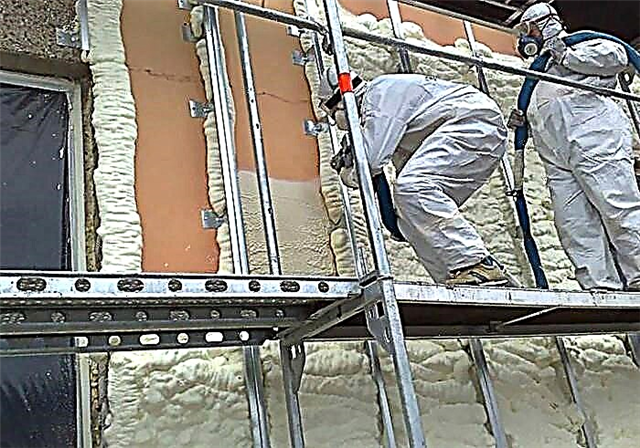 Next, the spaces between the crate are filled. Assistant transfers hoses of high-performance installation
Next, the spaces between the crate are filled. Assistant transfers hoses of high-performance installation
After applying and hardening the foam on the external or internal wall, it can be plastered and then painted.
How to choose a material
The market offers a wide range of materials for foam insulation. European foam insulation for walls guarantees high quality, but at a high price. Domestic manufacturers have mastered the production of licensed compositions and materials of their own design, at a significantly lower price, providing decent quality thermal insulation and a guaranteed service life. Experts identify manufacturers such as
Their advantage over nameless Chinese crafts is their well-known composition and quality control at all stages of production.
When choosing a foam designed for thermal insulation of external walls, you should check whether a specific material is recommended for outdoor use, whether it matches the density of available equipment and the final design density of the foam.
And if the savings on equipment are even more or less reasonable - it will be useful only once, then it’s definitely not worth saving on materials.
Types of foam insulation
Foam insulation can differ in its structure and composition. You can distinguish the main varieties of material for insulation of walls and windows:
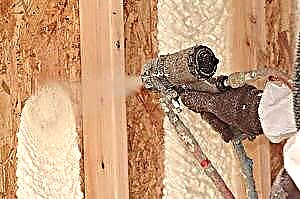 Penoizol. It contains aldehydes that are harmful to health, although manufacturers often claim the opposite. It dries much longer than polyurethane (full drying time can reach three days). It is usually used for insulation of attics, load-bearing walls and construction. Can be purchased in the form of ready-made plates or as a liquid composition.
Penoizol. It contains aldehydes that are harmful to health, although manufacturers often claim the opposite. It dries much longer than polyurethane (full drying time can reach three days). It is usually used for insulation of attics, load-bearing walls and construction. Can be purchased in the form of ready-made plates or as a liquid composition.- Ecowool and foam concrete. Can be purchased in liquid form, more often used to fill the foundation. When decorating facades, they are practically not used due to the significant weight, which gives a large load to the walls. In addition, the high cost often does not favor this material.
- Polyurethane foam. It is only suitable for sealing joints, joints, holes, as it does not allow moisture and steam to pass through, and this is a critical moment for insulation material. When interacting with air, its volume increases twenty times, while there is a minimal amount of air bubbles inside. Can be purchased in convenient small-capacity cylinders that have a significant shelf life.
- PPU or polyurethane. The most common option, which is considered the most universal. Polyurethane insulation is very effective as a thermal insulation of facades. It consists of two components, they need to be mixed by machine immediately before application. Foam expands from the initial volume thirty to forty times; small balloons form inside. Due to this, high-quality insulation of the house is achieved.
Which variety to choose
In many respects, the choice will depend on the specific situation, which area needs to be processed. You can use the example to consider the most common cases when a house needs foam insulation:
 If you need to repair cracks or eliminate any other defects on the surface, then polyurethane is suitable. But such material should not be exposed to sunlight.
If you need to repair cracks or eliminate any other defects on the surface, then polyurethane is suitable. But such material should not be exposed to sunlight.- If you need to fill a large volume, then penoizol is suitable. But an ordinary cylinder is not enough here, you will need to purchase a special high-pressure apparatus. Buying it is not necessary at all - you can rent it or borrow from friends, because often no one will use it.
- If you need to close up small cracks and conduct thermal insulation in small areas, you can buy a cylinder with ordinary mounting foam. It does not support combustion, after hardening it is particularly hard, while it has an ecological composition.
- If defects are found on the outside of the wall, then you need to apply a composition based on polyurethane. It is applied directly using a special balloon or apparatus.
 It is worth remembering that foam insulation creates errors within the layer that must be eliminated. This will require a long hose, which needs to push the material inward. If you want to fill the air gap inside the insulation, then holes are made in the wall with something sharp.
It is worth remembering that foam insulation creates errors within the layer that must be eliminated. This will require a long hose, which needs to push the material inward. If you want to fill the air gap inside the insulation, then holes are made in the wall with something sharp.
Foam is not suitable for warming the entire external facade - it does not have the appropriate characteristics necessary for this. Therefore, you should not choose it for these purposes, even despite its more economical cost.
Foam cost
If you buy a bottle at retail, then apiece, on average, you can give 300-500 rubles. That's just this type of insulation is rarely bought separately. Usually its cost is included in the cost of work:
- polyurethane foam - about 100 rubles per running meter,
- penoizol - 700−2000 rubles per cubic meter,
- polyurethane - 3000−5000 per cubic meter.
 The price of the material also plays a large role in its selection. But you should not save on high-quality thermal insulation if you need to insulate your home for a long time for a comfortable stay in it.
The price of the material also plays a large role in its selection. But you should not save on high-quality thermal insulation if you need to insulate your home for a long time for a comfortable stay in it.
Foam insulation suitable for most wallsincluding panel, block and aerated concrete. Therefore, they can be safely used as insulation for apartments and private houses. What kind of foam to choose is already a purely personal matter for everyone. But first, it still doesn’t bother to learn more about the selected composition, read reviews, get advice from the seller in a hardware store. It is not recommended to use a filling heater, which easily ignites in contrast to the foam refractory option. And it’s not the most convenient to use, the only exception is the surface of the floor.
Liquid foam insulation - more successful solution, because this procedure, if desired, can be carried out independently, without resorting to the help of specialists. If you do everything right and be careful, you will be able to quickly insulate any surface that needs it.

 Penoizol. It contains aldehydes that are harmful to health, although manufacturers often claim the opposite. It dries much longer than polyurethane (full drying time can reach three days). It is usually used for insulation of attics, load-bearing walls and construction. Can be purchased in the form of ready-made plates or as a liquid composition.
Penoizol. It contains aldehydes that are harmful to health, although manufacturers often claim the opposite. It dries much longer than polyurethane (full drying time can reach three days). It is usually used for insulation of attics, load-bearing walls and construction. Can be purchased in the form of ready-made plates or as a liquid composition. If you need to repair cracks or eliminate any other defects on the surface, then polyurethane is suitable. But such material should not be exposed to sunlight.
If you need to repair cracks or eliminate any other defects on the surface, then polyurethane is suitable. But such material should not be exposed to sunlight.
